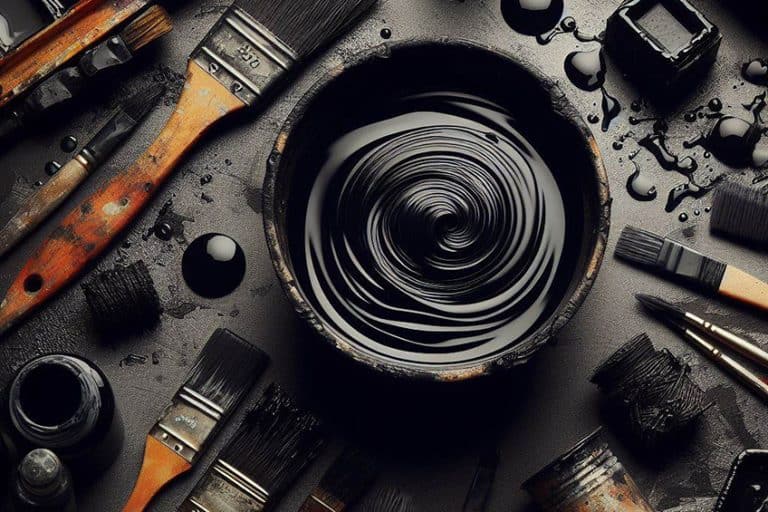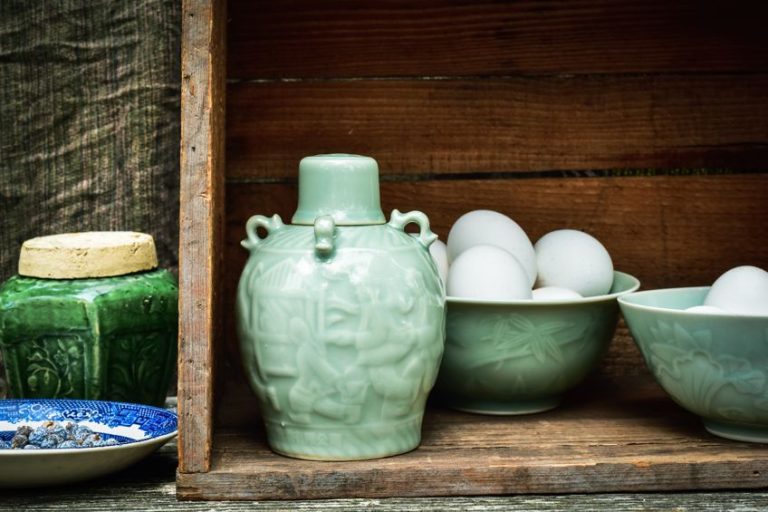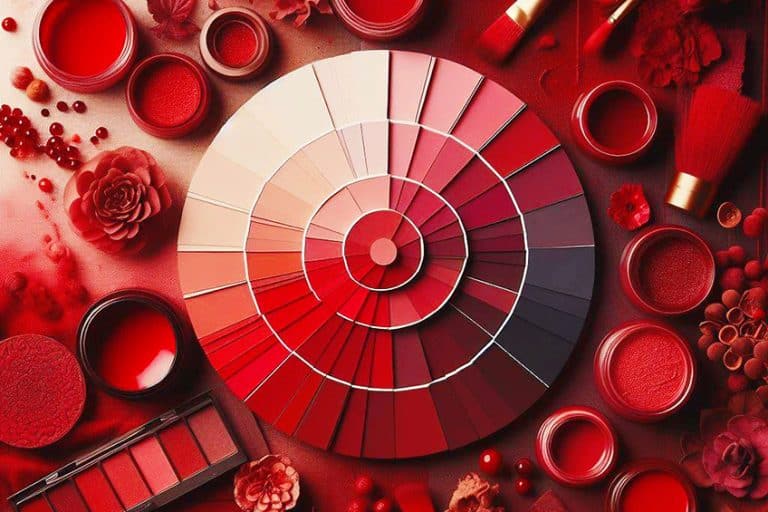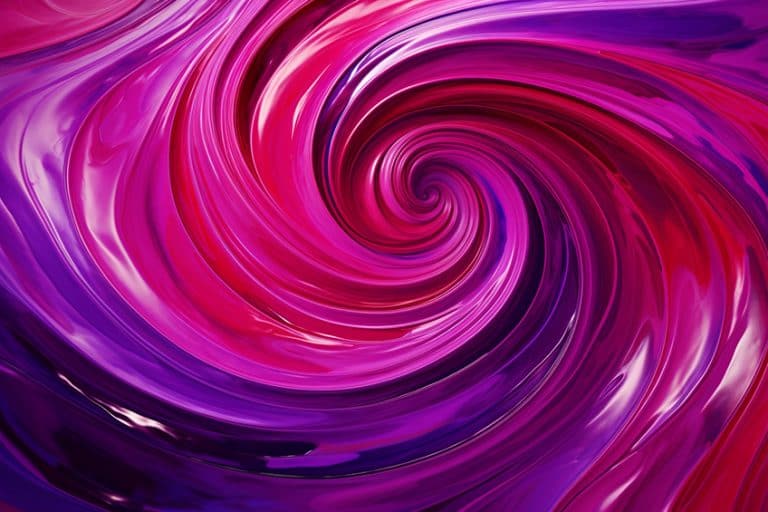What Colors Do Yellow and Brown Make? – Mixing Warm Shades
Yellow and brown are quite a common color combination in nature. Consider the trees in fall with their yellow leaves and brown bark, or a beautiful yellow and brown sunflower. So, we know that both these colors work well together, but what about brown and yellow mixed? Will these mixed colors make something less than appealing, or will the yellow-brown color be something you can use? Let us find out!
What Colors Do Yellow and Brown Make?
To provide a short answer to this question, when you mix brown and yellow, you will get a yellow-brown. However, the specific yellow-brown might vary according to how much of each color is added and what shade of color you used. The general outcome should be a lighter and brighter shade of brown due to the addition of yellow. In the table, we have taken a saddle brown, which has orange undertones, and combined this with a pure yellow. The resulting color is a strong yellow that is close to a shade of mustard.
Depending on the colors used, you can also get an olive, yellow ochre, or honey color.

| Shade | Hex Code | CMYK Color Code (%) | RGB Color Code | Color |
| Saddle Brown | #8b4513 | 0, 50, 86, 45 | 139, 69, 19 | |
| Yellow | #ffff00 | 0, 0, 100, 0 | 255, 255, 0 | |
| Strong Yellow | #c5a20a | 0, 18, 95, 23 | 197, 162, 10 | |
| Olive | #808000 | 0, 0, 100, 50 | 128, 128, 0 | |
| Yellow Ochre | #cb9d06 | 0, 23, 97, 20 | 203, 157, 6 | |
| Honey | #cb8e00 | 0, 30, 100, 20 | 203, 142, 0 |
Mixing Results for Different Shades of Yellow and Brown
| Yellow Shade | Brown Shade | Mixed Color |
|---|---|---|
| #FFFF00 | #A52A2A | #d29415 |
| #FFFF00 | #8B4513 | #c5a209 |
| #FFFF00 | #A0522D | #cfa816 |
| #FFFF00 | #D2691E | #e8b40f |
| #FFFF00 | #CD853F | #e6c21f |
| #CCCC00 | #A52A2A | #b87b15 |
| #CCCC00 | #8B4513 | #ab8809 |
| #CCCC00 | #A0522D | #b68f16 |
| #CCCC00 | #D2691E | #cf9a0f |
| #CCCC00 | #CD853F | #cca81f |
| #999900 | #A52A2A | #9f6115 |
| #999900 | #8B4513 | #926f09 |
| #999900 | #A0522D | #9c7516 |
| #999900 | #D2691E | #b5810f |
| #999900 | #CD853F | #b38f1f |
| #666600 | #A52A2A | #854815 |
| #666600 | #8B4513 | #785509 |
| #666600 | #A0522D | #835c16 |
| #666600 | #D2691E | #9c670f |
| #666600 | #CD853F | #99751f |
Understanding Yellow and Brown As Colors
When considering color theory, there are a few color models you can use. The most popular and well-known model is the RYB color system. This traditional color model is often used when you are mixing paint colors. A subtractive color mixing method is used, which means the color reflected is what you see, while all other color wavelengths have been absorbed. On the color wheel, you have your primary colors. These are red, yellow, and blue, which in this model cannot be created by mixing other hues. When mixing these pure colors, it will yield secondary colors. For example, red and yellow become orange, yellow and blue become green, and red and blue become purple. You can also mix your primary with your secondary colors, which will then give you the tertiary colors, also referred to as intermediate hues.

So, in this color model, we know that yellow is a primary color, but what about brown? You will not find brown on the color wheel, as it is not classified as a color.
You can create a grayish-brown by blending all of the primary colors. In theory, if you combine perfectly pure paint colors, it should produce black. However, this seldom occurs. In many cases, it can produce a color closer to gray if mixed in equal proportions. However, depending on the paints you use and the proportions, it can also produce a dark grayish-brown.

Another way that brown can be mixed is by using complementary colors. These colors are found opposite each other when you look at the color wheel. For example, the color that complements orange is blue, and mixing these two colors can produce a brownish color. However, mixing green and red, which are complementary colors, might lean more towards gray. So, again, it depends on the complementary colors or shades of color, and the proportions used.
Meaning of Yellow
Yellow is seen as a bright and happy hue that is also associated with joy, enthusiasm, optimism, and friendship. Yellow is also a stimulating color that can help to encourage creativity and help to produce mental clarity. Yellow is also a great color to help encourage communication and learning. Yellow is also often used as a color for caution. In some countries, such as Greece or Egypt, yellow is seen more as a sign of mourning. In Japan, yellow is seen as a sign of courage. In general, yellow also has a few negative associations.
Yellow can be seen as immature and is a sign of cowardice and fear. Too much yellow can also become irritating and can also be associated with impatience and impulsiveness.
Meaning of Brown
Brown is also categorized as a neutral color, which makes it quite versatile and compatible. Brown is often seen as a color related to the earth, which also makes it a very grounding, comforting, stable, and reliable color. Brown can also represent stability, security, and wisdom. However, brown can also be seen as somewhat boring and predictable. Lighter brown colors can also appear more welcoming, warm, and comforting, while darker browns are stronger, sophisticated, and more dramatic, but too much can also feel depressing.
Mixing Yellow and Brown Paint
Keeping with the traditional color system, yellow is a primary color. However, there you can most probably find many types of yellow, meaning that some yellows can appear brighter and warmer, while others are more subdued and cooler. Both yellow and brown are also considered warm colors, along with shades of red and orange. The temperature or color bias of a certain paint color can affect the outcome of a paint mixture. This means that even though yellow or brown are seen as warm colors, they can also have cooler undertones. This is what makes mixing colors quite challenging. When you purchase yellow or brown paint in a tube, it is always a good idea to check the pigments used. To really gain an understanding, it might be helpful to experiment with the different options available.
So, you can choose a brown color in a tube to mix with yellow, or you can create everything from your basic primary colors.
If you are going to mix complementary colors, you can use, for example, orange and blue. To create an orange, you will need to mix yellow and red. You can then mix the orange you created with your chosen blue color. Once you have achieved a brown color to your liking, by adding more yellow, you will brighten and lighten the brown and also make it a little warmer. The factors that will affect the color outcome include some of the following.
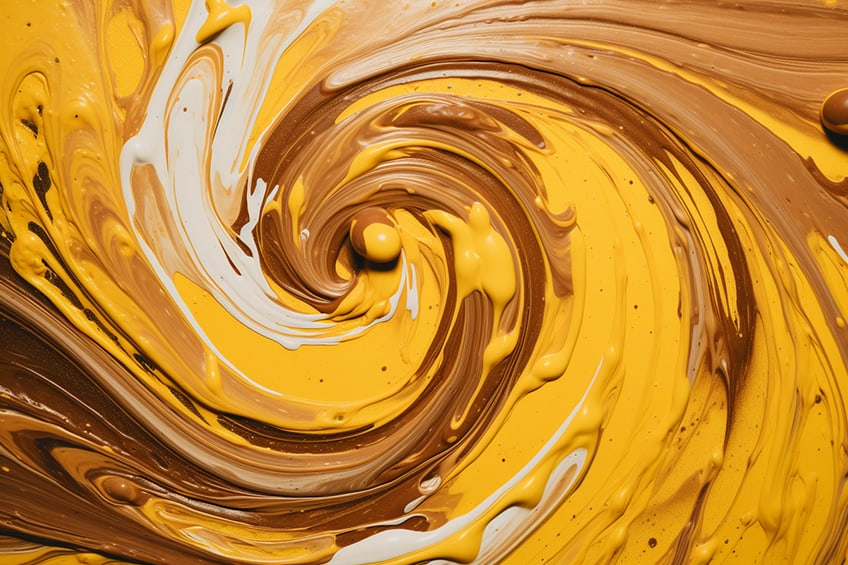
- Ratios or proportions used when mixing your colors can affect the final results.
- The particular shades of red, yellow, and blue used in the blend can play a role in determining the final color. For example, have you chosen a warm or cool yellow or red?
- The intensity of the brown and yellow can influence the final color created. For example, have you chosen a bright yellow or a muted yellow?
- A color can also be influenced by lighting, which means the final color can look different in natural light versus artificial lighting.
So, if you mix a lighter brown shade with a softer and paler yellow, it can produce something similar to a sandy beige. This is a warm, light, and more natural brown that can be used for many purposes. You can also try mixing a deeper reddish-brown, with a highly saturated and warm yellow ochre that should produce something similar to burnt sienna. A nice earthy and warm hue that is also a great choice for different design projects.

| Shade | Hex Code | CMYK Color Code (%) | RGB Color Code | Color |
| Sandy Beige | #dcd5b9 | 0, 3, 16, 14 | 220, 213, 185 | |
| Burnt Sienna | #e97451 | 0, 50, 65, 9 | 233, 116, 81 |
Creating Lighter and Darker Shades
Once you have brown and yellow mixed, you can then adjust the color to suit your needs. You can create a lighter version by adding white, which is also known as a tint. By adding white, the color will be toned down and less vibrant. So, to make it lighter and brighter, consider adding more yellow instead. To create a color shade, you can add a small quantity of black. Just remember to only add small amounts, as the black can quickly overwhelm everything.
However, when you mix brown and yellow, you can also use more brown than yellow to keep it darker. You can also add more blue to darken and make a cooler brown.
Understanding Yellow and Brown in Other Color Models
Moving on to other color models, the RBG color system is also widely used. This color system is used for mixing, or rather, layering different colored lights. Here additive color mixing is used, so if you merge all the colors in the color spectrum, it will create white light. The main primary hues here include red, blue, as well as green. The secondary hues are cyan, magenta, and yellow. So, in this model, yellow is a secondary color, and brown cannot be mixed as there is no such thing as brown light in the visible color spectrum.
As a color, brown is more of a perceived color that is achieved by how we see colored lights in context.
In most cases, we will be seeing orange, however, our brains interpret it as brown. So, you cannot mix brown and yellow when using colored lights. For example, the saddle brown we chose is simply a shade of dark orange. The color consists of 55 percent red, 27 percent green, and seven percent blue.

| Shade | Hex Code | CMYK Color Code (%) | RGB Color Code | Color |
| Saddle Brown | #8b4513 | 0, 50, 86, 45 | 139, 69, 19 |
Printing Color Model
When printing out documents on a printer that uses ink, you use another color model, which has cyan, magenta, and yellow as its primary colors. The secondary hues are then red, green, and blue. Yellow is again a primary color. When all of the primary colors in this model are blended, they will form black. Brown and yellow mixed in this case will produce something similar to the paints, which is a lighter version of brown.
Best Uses for Yellow and Brown in Art and Design
Yellow and brown are quite common colors and work quite well together. In art, brown is often applied as an underpainting, which can help to bring about a more cohesive feel and look to a painting. Brown is also applied to create a progression of dark to light. Yellow can be used to capture the nuances of light, as it can help produce brightness and highlights. Yellow is also found often in nature, so often paintings will contain yellow flowers or streaks of yellow in a sunset. Yellow can also be used to create various skin tones.
Of course, brown and yellow mixed can help to add more dimension. These colors can be used in any design project to create something unique and appealing.

Graphic Design
When dealing with graphic design and things like logos, colors play an important role as they help to project certain emotions and messages. Brown is a reliable color that is closely associated with earthiness. It is commonly used as a background color and helps to produce a certain sense of wholesomeness and warmth to a design. Yellow, on the other hand, is a fun and energetic color that makes a great accent color. Yellow also has various effects, such as being an appetite stimulant, which is why many restaurants use the color.
Too much yellow in a design though can become unsettling, so it should be used more sparingly.
Fashion Design
Brown and yellow are natural colors that remind us of fall and autumn leaves. Separately, brown is a popular color in fashion, as it is a neutral color that goes with most other colors. There are also many shades of brown you can work with to create a natural, minimalist look. Yellow can work with brown to create a great outfit. You can use any yellow including softer pastels and browns for a more subtle look or go bright yellow for a more eye-catching ensemble.

Interior Design
Brown and yellow can also be used in interior designs and look even better when paired with other neutrals like white. Using different shades of brown can also create a more interesting look. The bright nature of yellow can help to balance the more neutral tones of brown. You can also think about adding other colors like pink, or blues and greens.
You can choose a shade of brown to work as a neutral, which can be used to paint the walls.

Yellow can be brought in as an accent color, which can be done through things like furniture or cushions. You can choose a shade of yellow as your main color to paint the walls, but consider a paler shade used with brown and other neutral colors like white to balance it out. Instead of using brown couches or other materials, you can also consider natural elements like wood.
We have learned that when you mix brown and yellow, it will produce a brighter and lighter shade of brown, depending on the particular paint colors used. Since there are different shades of paint available, you will need to experiment with mixing the colors to find the perfect shade of yellow-brown that you are looking for.
Frequently Asked Questions
What Color Do Yellow and Brown Make?
When you mix brown and yellow paint colors, you should get another version of brown that appears brighter and lighter. Since there are different shades of paint available, you can mix anything from a lighter beige color to a darker, more earthy color.
Does Brown Go With Yellow?
Yes, yellow and brown work well together and can be used in a variety of design projects. The brown can act as a neutral, while the yellow can bring in a snap of color. There are also many variations of each color that you can use to create an appealing look.
Is Brown a Shade of Orange?
When using paints and pigments, brown is technically not a color and cannot be found on the color wheel. A neutral brown can be created by mixing the primary or complementary colors in different ratios. In the RGB color model, brown can be described as a shade of orange, but darker shades can be identified as brown, due to the way we perceive color.
In 2005, Charlene completed her Wellness Diplomas in Therapeutic Aromatherapy and Reflexology from the International School of Reflexology and Meridian Therapy. She worked for a company offering corporate wellness programs for a couple of years, before opening up her own therapy practice. It was in 2015 that a friend, who was a digital marketer, asked her to join her company as a content creator, and this is where she found her excitement for writing.
Since joining the content writing world, she has gained a lot of experience over the years writing on a diverse selection of topics, from beauty, health, wellness, travel, and more. Due to various circumstances, she had to close her therapy practice and is now a full-time freelance writer. Being a creative person, she could not pass up the opportunity to contribute to the Art in Context team, where is was in her element, writing about a variety of art and craft topics. Contributing articles for over three years now, her knowledge in this area has grown, and she has gotten to explore her creativity and improve her research and writing skills.
Charlene Lewis has been working for artincontext.org since the relaunch in 2020. She is an experienced writer and mainly focuses on the topics of color theory, painting and drawing.
Learn more about Charlene Lewis and the Art in Context Team.
Cite this Article
Charlene, Lewis, “What Colors Do Yellow and Brown Make? – Mixing Warm Shades.” Art in Context. November 14, 2023. URL: https://artincontext.org/what-colors-do-yellow-and-brown-make/
Lewis, C. (2023, 14 November). What Colors Do Yellow and Brown Make? – Mixing Warm Shades. Art in Context. https://artincontext.org/what-colors-do-yellow-and-brown-make/
Lewis, Charlene. “What Colors Do Yellow and Brown Make? – Mixing Warm Shades.” Art in Context, November 14, 2023. https://artincontext.org/what-colors-do-yellow-and-brown-make/.




